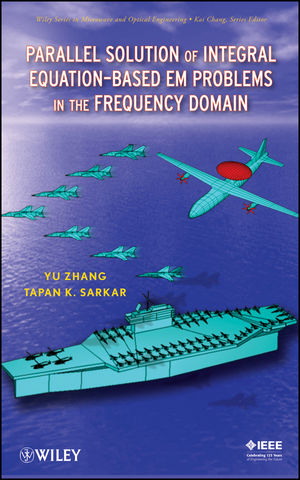Parallel Solution of Integral Equation-Based EM Problems in the Frequency DomainISBN: 978-0-470-40545-1
Hardcover
364 pages
June 2009, Wiley-IEEE Press
 |
||||||
Acknowledgments.
Acronyms.
Chapter 1 Introduction.
1.0 Summary.
1.1 A Brief Review of Parallel CEM.
1.2 Computer Platforms Accessed in This Book.
1.3 Parallel Libraries Employed for the Computations.
1.4 Conclusion.
References.
Chapter 2 In-Core and Out-of-Core LU Factorization for Solving a Matrix Equation.
2.0 Summary.
2.1 Matrix Equation from a MoM Code.
2.2 An In-Core Matrix Equation Solver.
2.3 Parallel Implementation of an In-Core Solver.
2.4 Data Decomposition for an Out-of-Core Solver.
2.5 Out-of-Core LU Factorization.
2.6 Parallel Implementation of an Out-of-Core LU Algorithm.
2.7 Solving a Matrix Equation Using the Out-of-Core LU Matrices.
2.8 Conclusion.
References.
Chapter 3 A Parallel MoM Code Using RWG Basis Functions and ScaLAPACK-Based In-Core and Out-of-Core Solvers.
3.0 Summary.
3.1 Electric Field Integral Equation (EFIE).
3.2 Use of the Piecewise Triangular Patch (RWG) Basis Functions.
3.3 Testing Procedure.
3.4 Matrix Equation for MoM.
3.5 Calculation of the Various Integrals.
3.6 Calculation of the Fields.
3.7 Parallel Matrix Filling - In-Core Algorithm.
3.8 Parallel Matrix Filling - Out-of-Core Algorithm.
3.9 Numerical Results from a Parallel In-Core MoM Solver.
3.10 Numerical Results from a Parallel Out-of-Core MoM Solver.
3.11 Conclusion.
References.
Chapter 4 A Parallel MoM Code Using Higher-Order Basis Functions and ScaLAPACK-Based In-Core and Out-of-Core Solvers.
4.0 Summary.
4.1 Formulation of the Integral Equation for Analysis of Dielectric Structures.
4.2 A General Formulation for the Analysis of Composite Metallic and Dielectric Structures.
4.3 Geometric Modeling of the Structures.
4.4 Higher-Order Basis Functions.
4.5 Testing Procedure.
4.6 Parallel In-Core and Out-of-Core Matrix Filling Schemes.
4.7 Numerical Results Computed on Different Platforms.
4.8 Conclusion.
References.
Chapter 5 Tuning the Performance of a Parallel Integral Equation Solver.
5.0 Summary.
5.1 Anatomy of a Parallel Out-of-Core Integral Equation Solver.
5.2 Block Size.
5.3 Shape of the Process Grid.
5.4 Size of the In-Core Buffer Allocated to Each Process.
5.5 Relationship between the Shape of the Process Grid and the In-Core Buffer Size.
5.6 Overall Performance of a Parallel Out-of-Core Solver on HPC Clusters.
5.7 Conclusion.
References.
Chapter 6 Refinement of the Solution Using the Iterative Conjugate Gradient Method.
6.0 Summary.
6.1 Development of the Conjugate Gradient Method.
6.2 The Iterative Solution of a Matrix Equation.
6.3 Parallel Implementation of the CG Algorithm.
6.4 A Parallel Combined LU-CG Scheme to Refine the LU Solution.
6.5 Conclusion.
References.
Chapter 7 A Parallel MoM Code Using Higher Order Basis Functions and PLAPACK Based In-Core and Out-of-Core Solvers.
7.0 Summary.
7.1 Introduction.
7.2 Factors that Affect a Parallel In-Core and Out-of-Core Matrix Filling Algorithm.
7.3 Numerical Results.
7.4 Conclusion.
References.
Chapter 8 Applications of the Parallel Frequency-Domain Integral Equation Solver—TIDES.
8.0 Summary.
8.1 Performance Comparison between TIDES and a Commercial EM Analysis Software.
8.2 EMC Prediction for Multiple Antennas Mounted on an Electrically Large Platform.
8.3 Analysis of Complex Composite Antenna Array.
8.4 Array Calibration for Direction-of-Arrival Estimation.
8.5 Radar Cross Section (RCS) Calculation of Complex Targets.
8.6 Analysis of Radiation Patterns of Antennas Operating Inside a Radome Along with the Platform on Which It Is Mounted.
8.7 Electromagnetic Interference (EMI) Analysis of a Communication System.
8.8 Comparison between Computations Using TIDES and Measurement data for Complex Composite Structures.
8.9 Conclusion.
References.
Appendix A: A Summary of the Computer Platforms Used in This Book.
A.0 Summary.
A.1 Description of the Platforms Used in This Book.
A.2 Conclusion.
References.
Appendix B: An Efficient Cross-Platform Compilation of the ScaLAPACK and PLAPACK Routines.
B.0 Summary.
B.1 Tools for Compiling both ScaLAPACK and PLAPACK.
B.2 Generating the ScaLAPACK Library.
B.3 Generating the PLAPACK Library.
B.4 Tuning the Performance by Turning on Proper Flags.
B.5 Conclusion.
References.
Appendix C: An Example of a Parallel MoM Source Code for Analysis of 2D EM Scattering.
C.0 Summary.
C.1 Introduction of MoM.
C.2 Solution of a Two Dimensional Scattering Problem.
C.3 Implementation of a Serial MoM Code.
C.4 Implementation of a Parallel MoM Code.
C.5 Compilation and Execution of the Parallel Code.
C.6 Conclusion.
References.
Index.



